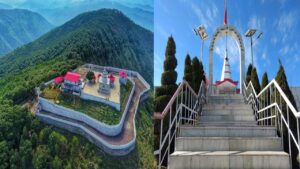Neelkanth Mahadev Temple: A Spiritual Retreat amidst the Himalayas

Neelkanth Mahadev Temple, located in Uttarakhand, India, is a renowned Hindu temple dedicated to Lord Shiva. It holds religious, mythological, and cultural significance.
Legend and Mythology
According to Hindu mythology, Neelkanth Mahadev Temple is associated with the divine event of Lord Shiva consuming the poison during the churning of the cosmic ocean. This act turned his throat blue, leading to his name “Neelkanth.”
Location and Surroundings
The temple is situated in the Pauri Garhwal district, approximately 1,330 meters (4,360 feet) above sea level. It offers breathtaking views of the Garhwal Himalayas and is surrounded by lush green forests, waterfalls, and serene landscapes.
Architecture and Design
The architectural style of Neelkanth Mahadev Temple showcases a blend of traditional and modern elements. The temple features intricate carvings, colorful paintings, and a beautiful sanctum where the main deity is enshrined.
Significance and Pilgrimage
The temple holds immense religious significance for devotees of Lord Shiva. It is a place of pilgrimage, attracting devotees from various parts of India and the world. The temple complex offers facilities for accommodation, food, and a clean environment.
Activities and Attractions
The surrounding area provides opportunities for various activities and attractions. Visitors can engage in hiking, nature walks, and birdwatching in the nearby forests and trails. The scenic beauty of the Ganges River and the snow-capped Himalayan peaks adds to the charm.
Spiritual Practices and Festivals
Neelkanth Mahadev Temple offers a serene atmosphere for meditation and yoga. Visitors can find solace and connect with their inner selves. Festivals like Maha Shivaratri are celebrated with great enthusiasm, immersing devotees in devotional chants and rituals.
| Topic | Description |
|---|---|
| Location | Pauri Garhwal district, Uttarakhand, India |
| Legend and Mythology | Lord Shiva consuming poison during the cosmic ocean churning |
| Architecture | A blend of traditional and modern elements |
| Significance | Religious pilgrimage site |
| Surroundings | Lush green forests, waterfalls, and Himalayan views |
| Activities | Hiking, nature walks, birdwatching, meditation, and yoga |
| Festivals | Maha Shivaratri and other religious celebrations |
| Conclusion | Spiritual retreat amidst the Himalayas |
Accessibility and Journey
To reach Neelkanth Mahadev Temple, visitors can undertake a moderate trek of approximately 14 kilometers (8.7 miles) from the town of Rishikesh. The trek offers picturesque landscapes, dense forests, and serene waterfalls, adding to the overall experience. Alternatively, one can also hire a taxi or take a bus to reach the temple.
Temple Complex and Deities
The temple complex of Neelkanth Mahadev consists of multiple structures and shrines. The main deity is Lord Shiva in the form of Neelkanth, known for his blue throat. The sanctum provides a sacred space for devotees to offer prayers and seek blessings. Additionally, the complex houses other deities, including Lord Ganesha and Goddess Parvati.
Pilgrimage Experience
Visiting Neelkanth Mahadev Temple offers a profound spiritual experience. The tranquil ambiance, surrounded by nature’s beauty, creates an atmosphere conducive to meditation and reflection. Devotees often perform rituals, chant prayers, and offer floral tributes to seek divine grace.
Cultural Significance
Beyond its religious importance, the temple is a cultural hub. It represents the rich heritage and traditions of the region. Festivals such as Maha Shivaratri, Kartik Purnima, and Shravan Maas witness vibrant celebrations with devotees coming together to honor Lord Shiva and partake in devotional activities.
Visitor Facilities
To accommodate the influx of pilgrims and tourists, Neelkanth Mahadev Temple offers various visitor facilities. These include restrooms, drinking water facilities, cloakrooms, and a designated area for prasad (offering) distribution. The temple management ensures a clean and well-maintained environment for a comfortable visit.
Conservation and Preservation
Efforts are made to preserve the natural surroundings and maintain the ecological balance around the temple. The authorities encourage responsible tourism practices and promote cleanliness and environmental awareness among visitors.
Spiritual Tourism and Beyond
Neelkanth Mahadev Temple serves as a prime destination for spiritual tourism. Its serene location amidst the Himalayas, coupled with its religious significance, attracts not only devotees but also tourists seeking a blend of spirituality and natural beauty. The temple’s popularity has contributed to the growth of tourism in the region, benefiting the local economy.
Continuing Legacy
Neelkanth Mahadev Temple stands as a testament to the devotion and reverence of Lord Shiva’s followers. It’s timeless appeal and cultural significance continue to inspire countless pilgrims and visitors, leaving an indelible mark on their spiritual journeys.
Neelkanth Mahadev Mela
The Neelkanth Mahadev Mela is an annual fair that takes place near the temple premises. The fair attracts a large number of devotees, locals, and tourists. It is a vibrant celebration featuring colorful stalls, cultural performances, folk music, and traditional dances. The fair provides a glimpse into the local customs and traditions of the region.
Nearby Attractions
Apart from the temple itself, there are several other attractions in the vicinity that visitors can explore. The famous Triveni Ghat in Rishikesh, where the Ganges, Yamuna, and Saraswati rivers converge, is a significant spiritual site located just a short distance away. The iconic Laxman Jhula and Ram Jhula suspension bridges are also popular tourist spots in Rishikesh.
Neelkanth Mahadev Temple Timings:
- Opening Time: The temple opens early in the morning, usually around 6:00 AM.
- Morning Prayer and Darshan: Devotees can attend the morning prayer and have a darshan (viewing) of the deity. This usually takes place between 6:30 AM and 12:00 PM.
- Afternoon Closure: The temple closes for a few hours in the afternoon. The exact closure time can vary but is typically from around 12:00 PM to 4:00 PM.
- Evening Prayer and Darshan: The temple reopens in the late afternoon or early evening, around 4:00 PM.
- Evening Aarti: The evening prayer and aarti (ritual offering of light) take place, creating a serene and devotional atmosphere.
- Closing Time: The temple closes for the day after the evening aarti. The closing time can vary but is usually around 8:00 PM or later.








